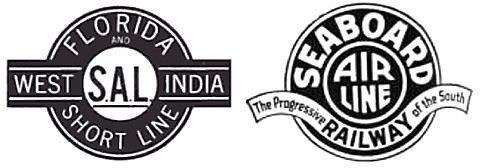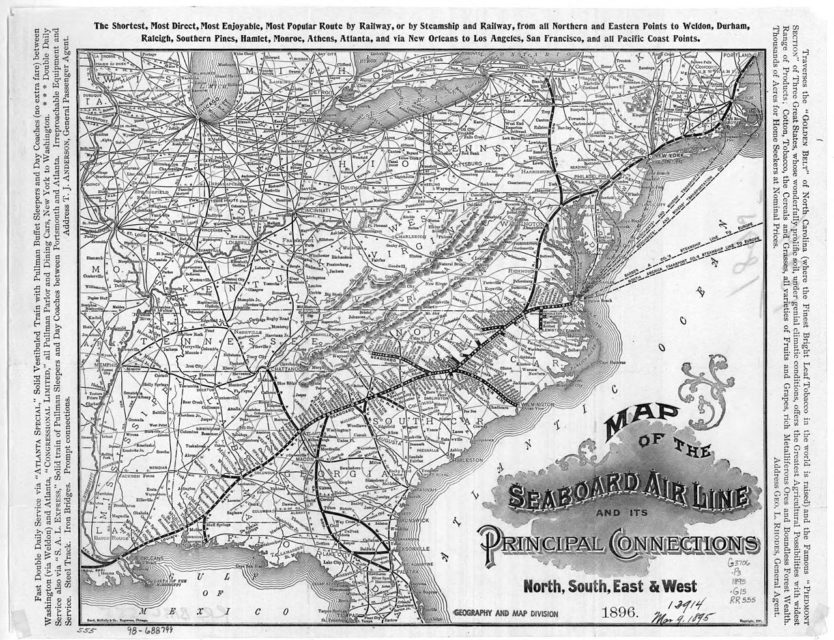
Seaboard Air Line logos used in print advertising, circa 1900 (left) and 1916 (right).
Wikimedia Commons.
This month’s Classic Trains fallen flag feature is the Seaboard Air Line by Larry Goolsby. The railroad’s earliest antecedent was originally chartered in 1832 to build a rail line from Portsmouth, Virginia to Weldon, North Carolina, a port on the Roanoke River which flows into Albemarle Sound. The Portsmouth & Roanoke began operation in 1834 and changed its name to the Seaboard & Roanoke around 1838 after several financial reorganizations and refinancing efforts. In 1837, the first passenger fatalities in US railroad history occurred in a head-on collision between a eastbound lumber train hit the westbound passenger train from Portsmouth on 11 August. Three young women were killed in the accident, all members of the Ely family.
Along with most other railroads in the Confederate states, Virginian and North Carolinian railroads were seriously damaged physically in the fighting and became political footballs during the Reconstruction Era. In the 1880s, the Seaboard and Roanoke was one of several railroads merged to form the Seaboard Air Line Railway which extended from Virginia to Georgia. The name Seaboard Air Line was in use well before the legal merger as a marketing device to help attract traffic.
The “Air Line” name was often used by railroads of the period to denote a route supposedly “as straight as the crow flies.” It was a reasonably direct run from Portsmouth to Weldon, but the Air Line label would be more than hype when in the 1880s Seaboard acquired a line linking Hamlet and Wilmington, N.C., which included a 79-mile tangent track, longest in the U.S.
As the 19th century closed, the SAL system came under control of a group led by John Skelton Williams, who added a line from Richmond, Va., to Weldon, and acquired the Florida Central & Peninsular, transforming what had been a Portsmouth–Atlanta carrier into a north-south line. In 1900, the various SAL roads were incorporated as Seaboard Air Line Railway with its coastal main line from Richmond going through Raleigh, Columbia, and Savannah to Jacksonville and Tampa.
While the World War II years strained SAL’s resources the railroad shouldered the load with new EMD FTs, secondhand steam engines from Western Maryland and Chicago & North Western, and installation of block signals and centralized traffic control over large portions of its main line. Wartime income helped the carrier emerge from receivership in 1946 as Seaboard Air Line Railroad.
High-profile wrecks, several involving passenger trains, spurred quick postwar completion of the signaling and modernization campaign. SAL’s earliest CTC installation had started south from Richmond in 1941. By the early 1950s, signals covered most mainline mileage, keeping the operation competitive with its double-tracked neighbor Atlantic Coast Line.
Seaboard added more streamlined cars from Budd in 1947 and lightweight sleepers from several builders beginning in 1949. The Silver Star name was given to what had been a second section of the Meteor, and the two “Silver Fleet” members held down the first-class New York–Florida trade. The Silver Comet was added to the New York–Birmingham route. Seaboard continued to maintain its premier trains to high standards into the 1960s, proudly calling itself “The Route of Courteous Service.” The Meteor and Star names survive on Amtrak’s New York–Miami route.
As with so many North American railways after World War II, the Seaboard faced stiff competition not only from direct competitors like the Atlantic Coast Line, but also from trucks diverting freight onto the interstate highway system but also from airlines whisking its passengers more rapidly to holiday destinations in Florida. The economic situation was clear in the mid-1950s and Seaboard applied for government approval to merge operations with rival Atlantic Coast in 1958, but did not get through the legal obstacle course until 1967 when the merger was formalized as the new Seaboard Coast Line Railroad.




